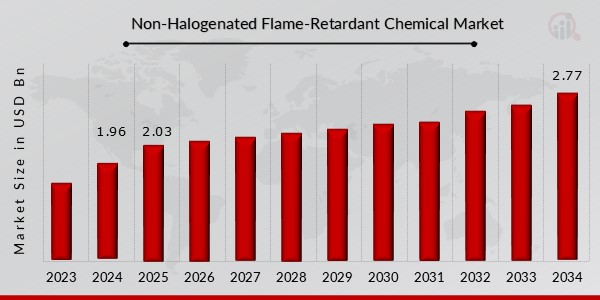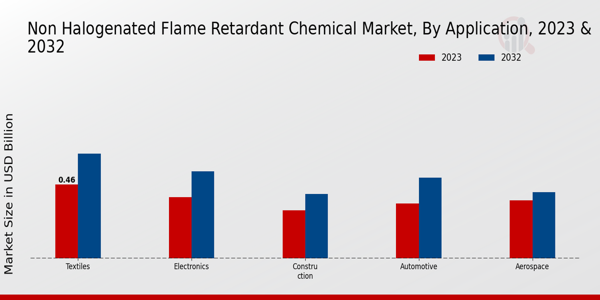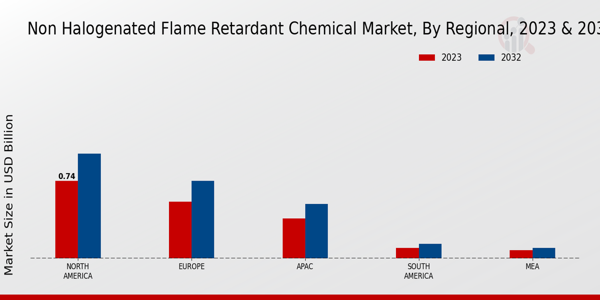Global Non-Halogenated Flame-Retardant Chemical Market Overview
The Non-Halogenated Flame-Retardant Chemical Market Size was estimated at 1.96 (USD Billion) in 2024.The Non-Halogenated Flame-Retardant Chemical Industry is expected to grow from 2.03(USD Billion) in 2025 to 2.77 (USD Billion) by 2034. The Non-Halogenated Flame-Retardant Chemical Market CAGR (growth rate) is expected to be around 3.5% during the forecast period (2025 - 2034).
Key Non-Halogenated Flame-Retardant Chemical Market Trends Highlighted
The Non-Halogenated Flame-Retardant Chemical Market is experiencing significant growth due to several key drivers. One primary factor is the increasing demand for safety and fire resistance in various applications, especially in industries like construction, automotive, and electronics. As regulations surrounding safety standards become more stringent, manufacturers are shifting toward non-halogenated options to ensure compliance while still providing effective fire protection. Furthermore, the growing awareness regarding the environmental and health risks associated with halogenated flame retardants is pushing consumers and businesses alike to seek safer alternatives.Opportunities in the market are abundant as innovations in non-halogenated formulations continue to evolve.
Companies are increasingly focusing on developing new compounds that not only enhance fire resistance but also maintain performance characteristics in terms of durability and application versatility. The expanding market for eco-friendly materials is another avenue that can be explored, as manufacturers strive to create sustainable products that align with consumer expectations and regulatory frameworks.
This shift presents an opportunity for businesses to invest in research and development to create superior non-halogenated solutions that meet the rising demand for greener alternatives.In recent times, there has been a noticeable trend towards the incorporation of non-halogenated flame retardants in a wider range of products, highlighting their versatility and adaptability. As industries embrace sustainability, the integration of these chemicals into new technologies and materials signifies a proactive approach to health and safety.
The appeal of non-halogenated options is likely to grow as industries increasingly recognize their benefits, prompting a shift in consumer preferences and encouraging ongoing innovation within the market. This evolving dynamic presents a promising future for the Non-Halogenated Flame-Retardant Chemical Market, with continuous advancements and growing market acceptance.

Source: Primary Research, Secondary Research, Market Research Future Database and Analyst Review
Non-Halogenated Flame-Retardant Chemical Market Drivers
Increasing Demand for Fire Safety Regulations
The Non-Halogenated Flame-Retardant Chemical Market Industry is experiencing significant growth driven by the intensification of fire safety regulations across various sectors such as construction, electronics, and automotive. Governments and regulatory bodies around the world are implementing stringent fire safety standards to protect public health and ensure safety against fire hazards.
This escalating demand for enhanced fire safety measures is propelling manufacturers to adopt non-halogenated flame retardants, which are considered safer alternatives to traditional halogenated compounds that can emit harmful substances during combustion.These regulations not only aim to reduce the risks associated with flammability but also encourage the use of environmentally friendly materials. As industries align their products with these regulations, the Non-Halogenated Flame-Retardant Chemical Market is expected to grow significantly.
Moreover, the pressing need for sustainability in product development is further pushing manufacturers to explore safer alternatives that contribute to a greener environment.This trend is translating into an upward trajectory for the demand for non-halogenated flame retardants as companies increasingly focus on promoting sustainable practices while adhering to fire safety standards. Consequently, the overall growth of the Non-Halogenated Flame-Retardant Chemical Market Industry is expected to benefit substantially from these regulatory pressures, paving the way for continued innovation and competitive differentiation among manufacturers.
Rising Awareness of Environmental Impact
Growing awareness about the environmental impact of chemicals used in various industries is a crucial driver for the Non-Halogenated Flame-Retardant Chemical Market Industry. Consumers and manufacturers alike are increasingly prioritizing eco-friendly alternatives, and this shift is leading to a significant demand for non-halogenated flame retardants. The adverse effects of halogenated flame retardants on the environment and human health have raised alarm bells, catalyzing a transition towards safer chemical solutions.As industries seek to enhance their sustainability profiles, the preference for non-halogenated products is becoming more pronounced, thus positively impacting market growth.
Technological Advancements in Non Halogenated Solutions
Technological innovations have played a pivotal role in the development of effective non-halogenated flame retardants, bolstering their performance and acceptance in various applications. Research and development efforts are yielding new formulations that not only meet stringent fire safety standards but also offer enhanced performance characteristics, such as improved thermal stability and lower toxicity.
This advancement in technology is crucial for expanding the applications of non-halogenated flame retardants across diverse sectors like textiles, plastics, and electronics.As manufacturers strive to elevate product quality and safety while adhering to environmental standards, the continuous evolution of non-halogenated solutions is expected to drive significant growth in the Non-Halogenated Flame-Retardant Chemical Market Industry.
Non-Halogenated Flame-Retardant Chemical Market Segment Insights
Non-Halogenated Flame-Retardant Chemical Market Application Insights
The Non-Halogenated Flame-Retardant Chemical Market is projected to experience noteworthy growth across various applications, which contribute significantly to its overall market revenue. In 2023, the market is valued at 1.84 USD Billion, with expectations of reaching 2.5 USD Billion by 2032. The Application segment includes critical industries such as Textiles, Electronics, Construction, Automotive, and Aerospace. Among these, the Textiles sector exhibits a substantial share, valued at 0.46 USD Billion in 2023, and forecasted to increase to 0.65 USD Billion by 2032.
This sector's importance stems from the growing demand for safe and flame-resistant materials in clothing and furnishings, coupled with regulatory pressures to enhance fire safety standards. The Electronics industry follows closely, with a market valuation of 0.38 USD Billion in 2023 and an anticipated rise to 0.54 USD Billion by 2032.
The need for flame retardant materials in electronic devices is compelling, driven by advancements in technology and an increase in electronic waste concerns, thus securing its place as a significant segment.Construction also plays a critical role in the Non-Halogenated Flame-Retardant Chemical Market, initially valued at 0.3 USD Billion in 2023 and projected to reach 0.4 USD Billion by 2032. With stricter building codes aimed at enhancing fire safety across commercial and residential structures, the demand for flame retardants is on the rise, highlighting the segment's relevance.
Additionally, the Automotive sector, showing a valuation of 0.34 USD Billion in 2023 and expected to grow to 0.5 USD Billion by 2032, indicates increasing regulatory standards for vehicle fire resistance, making it a vital player in the market’s landscape. Finally, the Aerospace domain, valued at 0.36 USD Billion in 2023 and anticipated to rise slightly to 0.41 USD Billion by 2032, underscores the demand for fire-retardant materials due to safety regulations in aircraft manufacturing. Overall, the Non-Halogenated Flame-Retardant Chemical Market segmentation illustrates the importance of each application, driven by safety concerns, technological advancements, and compliance with ongoing regulatory changes.
The combination of these robust segments indicates a steady growth trajectory in the market, nurturing significant opportunities and challenges in its development and innovation landscape.

Source: Primary Research, Secondary Research, Market Research Future Database and Analyst Review
Non-Halogenated Flame-Retardant Chemical Market Chemical Type Insights
The Non-Halogenated Flame-Retardant Chemical Market, valued at 1.84 billion USD in 2023, showcases a diverse segmentation focusing on various chemical types essential for enhancing fire safety across multiple industries. Each chemical type plays a critical role in meeting safety standards while addressing environmental concerns. The Esters segment is significant for its effectiveness and versatility in applications, offering a balanced approach to performance and safety. Phosphorus Compounds have gained traction due to their superior flame-retardant properties, making them vital in the automotive and electronics sectors.Nitrogen Compounds are important for their cost-effectiveness and ability to provide good thermal stability.
Magnesium Hydroxide and Aluminum Hydroxide dominate the market due to their non-toxic nature and use in various applications, including construction and textiles. Market growth is driven by increasing regulations on fire safety and a shift towards sustainable, eco-friendly solutions. Despite the positive outlook, challenges arise from the need for continuous innovation and stringent environmental regulations impacting the production processes.Overall, the Non-Halogenated Flame-Retardant Chemical Market is evolving, supporting a shift toward safer chemical alternatives.
Non-Halogenated Flame-Retardant Chemical Market End Use Industry Insights
The Non-Halogenated Flame-Retardant Chemical Market is projected to be valued at 1.84 billion USD in 2023 and is anticipated to encompass various end-use industries that significantly drive its growth. The building and construction sector represents a major area of application, primarily due to stringent fire safety regulations and the increasing adoption of sustainable materials. Similarly, the electrical and electronics industry continues to play a crucial role in market development, as the demand for safer and more efficient materials rises amid advancing technologies.Transportation also contributes substantially, with non-halogenated flame retardants being essential in enhancing safety across vehicles and aircraft.
Consumer goods and industrial applications round out the market, with an increasing emphasis on protective measures as well as compliance with safety standards. The dynamic nature of these segments reflects the growing awareness of environmental concerns and the need for products that minimize health risks. As the Non-Halogenated Flame-Retardant Chemical Market data indicates steady market growth, challenges such as balancing effectiveness with environmental impact remain pivotal for companies navigating these diverse industries.
Non-Halogenated Flame-Retardant Chemical Market Form Insights
The Non-Halogenated Flame-Retardant Chemical Market, specifically within the Form segment, was valued at 1.84 USD billion in 2023 and is projected to witness steady growth leading to a valuation of 2.5 USD billion by 2032. This segment encompasses various forms including Liquid, Powder, Granules, Masterbatches, and Concentrates, each playing a critical role in the market landscape. Liquid flame retardants are particularly prevalent in applications requiring easy integration into various materials, while Powder forms are favored for their efficiency and wide-ranging applications in construction and textiles.Granules are also significant as they offer versatility, especially in plastic processing.
Masterbatches, essential for tailored formulations, are gaining importance due to increasing demands for customized solutions in manufacturing. Concentrates dominate by offering enhanced performance in flame retardancy, catering to a wide array of industrial needs. The overall demand in the Non-Halogenated Flame-Retardant Chemical Market is driven by stringent regulations regarding fire safety and a growing focus on environmental sustainability, although challenges such as regulatory hurdles and the need for technological advancements do exist, presenting opportunities for innovation and market growth.
Non-Halogenated Flame-Retardant Chemical Market Regional Insights
The Non-Halogenated Flame-Retardant Chemical Market is forecasted to reach a substantial valuation of 1.84 USD Billion in 2023, reflecting a significant demand across various regions. North America emerges as a dominant player, holding a value of 0.74 USD Billion in 2023, and projected to increase to 1.0 USD Billion by 2032, thereby indicating its majority holding in the market.
Europe follows closely with a market valuation of 0.54 USD Billion in 2023, which is anticipated to grow to 0.74 USD Billion, highlighting Europe’s commitment to safety and regulatory compliance in materials.Meanwhile, the APAC region, valued at 0.38 USD Billion, shows potential for growth with a projection to reach 0.52 USD Billion, driven by burgeoning manufacturing sectors in countries like China and India.
South America and the MEA regions, while smaller, show a steady trend with the former valued at 0.1 USD Billion and expected to rise to 0.14 USD Billion, and MEA at 0.08 USD Billion slated to grow to 0.1 USD Billion up to 2032. The overall diversity in regional valuations reflects varying regulatory environments and safety standards, which significantly impact the growth trajectories noted in the Non-Halogenated Flame-Retardant Chemical Market statistics, underlining both present opportunities and challenges for market participants.

Source: Primary Research, Secondary Research, Market Research Future Database and Analyst Review
Non-Halogenated Flame-Retardant Chemical Market Key Players and Competitive Insights
The Non-Halogenated Flame-Retardant Chemical Market has become increasingly significant as industries prioritize safety and regulatory compliance. Non-halogenated flame retardants have emerged as alternatives to halogenated compounds due to their lower toxicity and environmental impact, driving innovation and competition across the market. Companies are focusing on developing advanced solutions that meet stringent safety standards, thereby enhancing their market positions. Intense competition among key players has resulted in a dynamic landscape characterized by strategic partnerships, technological advancements, and expansion into emerging markets.
As industries such as construction, automotive, and electronics demand more sustainable materials, the market is poised for growth, making competitive insights crucial for stakeholders.LANXESS has established a prominent position in the Non-Halogenated Flame-Retardant Chemical Market by leveraging its specialized chemical expertise and broad product portfolio. With a strong commitment to sustainability and safety, LANXESS has developed a range of non-halogenated flame retardant solutions that meet the evolving needs of various industries.
The company's innovation-driven approach has enabled it to introduce high-performance products that comply with international regulations, positioning LANXESS as a reliable partner for manufacturers seeking environmentally friendly fire safety alternatives. Furthermore, the company’s focus on strategic alliances and investments in research and development enhances its competitive strength and expands its market reach, allowing LANXESS to stay ahead in a rapidly growing sector.Dow Chemical also plays a vital role in the Non-Halogenated Flame-Retardant Chemical Market by offering a range of innovative and effective flame retardant solutions.
The company's strong emphasis on sustainability and technological advancement has led to the development of versatile non-halogenated products suitable for multiple applications, including electronics, construction, and textiles. Dow Chemical’s deep commitment to research allows it to continuously improve product performance while ensuring compliance with global safety regulations. Additionally, its robust supply chain and extensive market presence serve as significant advantages, allowing Dow Chemical to effectively meet customer demands while reinforcing its position as a leading player in the non-halogenated flame retardants sector.
The company's strategic initiatives aimed at enhancing product offerings and expanding into new markets further solidify its competitive edge in this growing industry.
Key Companies in the Non-Halogenated Flame-Retardant Chemical Market Include
- Valtris Specialty Chemicals
Non-Halogenated Flame-Retardant Chemical Market Industry Developments
Recent developments in the Non-Halogenated Flame-Retardant Chemical Market highlight a growing focus on sustainability and regulatory compliance, with many companies intensifying their research and development efforts. Notable players such as LANXESS and Dow Chemical continue to innovate in the realm of non-halogenated formulations, responding to increasing demand for safer fire-resistant materials. Huntsman has also strengthened its product line to align with stricter environmental standards. In terms of mergers and acquisitions, ExxonMobil’s strategic moves to enhance its flame retardant offerings have drawn attention, as well as ICL Group's recent acquisitions aimed at bolstering its market presence.
Companies like Albemarle and Nabaltec AG are seeing growth in market valuation attributed to increased applications across electronics and construction industries, further driving the demand for their products. As regulations surrounding flame retardants tighten, firms like BASF and Clariant are investing substantially to adapt their portfolios, underscoring the competitive landscape of this market. The integration of advanced technologies and the emphasis on product performance are key factors influencing the dynamics within the Non-Halogenated Flame-Retardant Chemical Market.
Non-Halogenated Flame-Retardant Chemical Market Segmentation Insights
Non-Halogenated Flame-Retardant Chemical Market Application Outlook
Non-Halogenated Flame-Retardant Chemical Market Chemical Type Outlook
Non-Halogenated Flame-Retardant Chemical Market End Use Industry Outlook
- Building and Construction
- Electrical and Electronics
Non-Halogenated Flame-Retardant Chemical Market Form Outlook
Non-Halogenated Flame-Retardant Chemical Market Regional Outlook
| Report Attribute/Metric |
Details |
| Market Size 2024 |
1.96(USD Billion) |
| Market Size 2025 |
2.03 (USD Billion) |
| Market Size 2034 |
2.77 (USD Billion) |
| Compound Annual Growth Rate (CAGR) |
3.5% (2025 - 2034) |
| Report Coverage |
Revenue Forecast, Competitive Landscape, Growth Factors, and Trends |
| Base Year |
2024 |
| Market Forecast Period |
2025 - 2034 |
| Historical Data |
2020 - 2024 |
| Market Forecast Units |
USD Billion |
| Key Companies Profiled |
LANXESS, Dow Chemical, Huntsman, ExxonMobil, ICL Group, Albemarle, Nabaltec AG, Marubeni Corporation, Everlode, Valtris Specialty Chemicals, BASF, Clariant, DuPont, Bromine Compounds, Solvay |
| Segments Covered |
Application, Chemical Type, End Use Industry, Form, Regional |
| Key Market Opportunities |
Increasing regulations on halogenated substances, Growing demand in automotive industry, Expansion in electrical and electronics sector, Rising awareness of environmental safety, Development of bio-based flame retardants |
| Key Market Dynamics |
Increasing regulatory scrutiny, Rising awareness for safety, Shift towards sustainable solutions, Growing demand in electronics, Expanding automotive applications |
| Countries Covered |
North America, Europe, APAC, South America, MEA |
Frequently Asked Questions (FAQ):
The market size of the Non-Halogenated Flame-Retardant Chemical Market is expected to be valued at 1.96 USD Billion in 2024.
By 2034, the market is projected to reach a value of 2.77 USD Billion.
The expected CAGR for the Non-Halogenated Flame-Retardant Chemical Market from 2025 to 2034 is 3.5%.
In 2023, North America is expected to hold the largest market share, valued at 0.74 USD Billion.
The North American segment is projected to grow to 1.0 USD Billion by 2032.
The application segments driving the market include Textiles, Electronics, Construction, Automotive, and Aerospace.
The Textile application segment is expected to be valued at 0.65 USD Billion in 2032.
Key players in the market include LANXESS, Dow Chemical, Huntsman, ExxonMobil, and ICL Group.
The Aerospace application segment is estimated to be valued at 0.36 USD Billion in 2023.
Emerging trends include increased regulatory standards and growing demand for safer flame retardant alternatives affecting market dynamics.
















